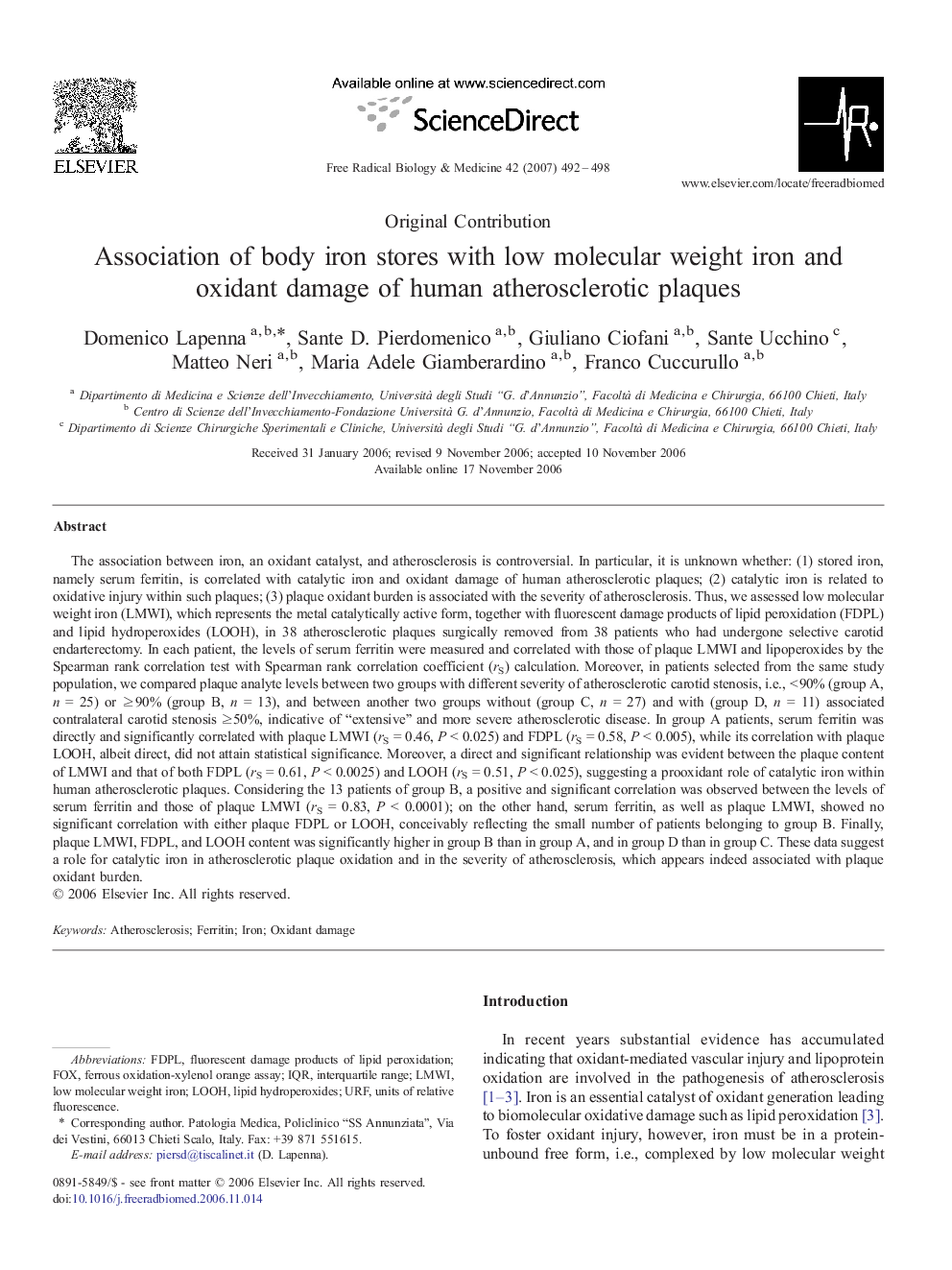| کد مقاله | کد نشریه | سال انتشار | مقاله انگلیسی | نسخه تمام متن |
|---|---|---|---|---|
| 1910653 | 1046781 | 2007 | 7 صفحه PDF | دانلود رایگان |
عنوان انگلیسی مقاله ISI
Association of body iron stores with low molecular weight iron and oxidant damage of human atherosclerotic plaques
دانلود مقاله + سفارش ترجمه
دانلود مقاله ISI انگلیسی
رایگان برای ایرانیان
کلمات کلیدی
موضوعات مرتبط
علوم زیستی و بیوفناوری
بیوشیمی، ژنتیک و زیست شناسی مولکولی
سالمندی
پیش نمایش صفحه اول مقاله

چکیده انگلیسی
The association between iron, an oxidant catalyst, and atherosclerosis is controversial. In particular, it is unknown whether: (1) stored iron, namely serum ferritin, is correlated with catalytic iron and oxidant damage of human atherosclerotic plaques; (2) catalytic iron is related to oxidative injury within such plaques; (3) plaque oxidant burden is associated with the severity of atherosclerosis. Thus, we assessed low molecular weight iron (LMWI), which represents the metal catalytically active form, together with fluorescent damage products of lipid peroxidation (FDPL) and lipid hydroperoxides (LOOH), in 38 atherosclerotic plaques surgically removed from 38 patients who had undergone selective carotid endarterectomy. In each patient, the levels of serum ferritin were measured and correlated with those of plaque LMWI and lipoperoxides by the Spearman rank correlation test with Spearman rank correlation coefficient (rS) calculation. Moreover, in patients selected from the same study population, we compared plaque analyte levels between two groups with different severity of atherosclerotic carotid stenosis, i.e., < 90% (group A, n = 25) or â¥Â 90% (group B, n = 13), and between another two groups without (group C, n = 27) and with (group D, n = 11) associated contralateral carotid stenosis â¥50%, indicative of “extensive” and more severe atherosclerotic disease. In group A patients, serum ferritin was directly and significantly correlated with plaque LMWI (rS = 0.46, P < 0.025) and FDPL (rS = 0.58, P < 0.005), while its correlation with plaque LOOH, albeit direct, did not attain statistical significance. Moreover, a direct and significant relationship was evident between the plaque content of LMWI and that of both FDPL (rS = 0.61, P < 0.0025) and LOOH (rS = 0.51, P < 0.025), suggesting a prooxidant role of catalytic iron within human atherosclerotic plaques. Considering the 13 patients of group B, a positive and significant correlation was observed between the levels of serum ferritin and those of plaque LMWI (rS = 0.83, P < 0.0001); on the other hand, serum ferritin, as well as plaque LMWI, showed no significant correlation with either plaque FDPL or LOOH, conceivably reflecting the small number of patients belonging to group B. Finally, plaque LMWI, FDPL, and LOOH content was significantly higher in group B than in group A, and in group D than in group C. These data suggest a role for catalytic iron in atherosclerotic plaque oxidation and in the severity of atherosclerosis, which appears indeed associated with plaque oxidant burden.
ناشر
Database: Elsevier - ScienceDirect (ساینس دایرکت)
Journal: Free Radical Biology and Medicine - Volume 42, Issue 4, 15 February 2007, Pages 492-498
Journal: Free Radical Biology and Medicine - Volume 42, Issue 4, 15 February 2007, Pages 492-498
نویسندگان
Domenico Lapenna, Sante D. Pierdomenico, Giuliano Ciofani, Sante Ucchino, Matteo Neri, Maria Adele Giamberardino, Franco Cuccurullo,